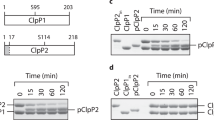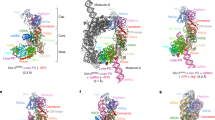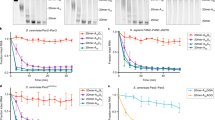Abstract
Decapping is a key step in both general and nonsense-mediated 5′ → 3′ mRNA-decay pathways. Removal of the cap structure is catalyzed by the Dcp1–Dcp2 complex. The crystal structure of a C-terminally truncated Schizosaccharomyces pombe Dcp2p reveals two distinct domains: an all-helical N-terminal domain and a C-terminal domain that is a classic Nudix fold. The C-terminal domain of both Saccharomyces cerevisiae and S. pombe Dcp2p proteins is sufficient for decapping activity, although the N-terminal domain can affect the efficiency of Dcp2p function. The binding of Dcp2p to Dcp1p is mediated by a conserved surface on its N-terminal domain, and the N-terminal domain is required for Dcp1p to stimulate Dcp2p activity. The flexible nature of the N-terminal domain relative to the C-terminal domain suggests that Dcp1p binding to Dcp2p may regulate Dcp2p activity through conformational changes of the two domains.
This is a preview of subscription content, access via your institution
Access options
Subscribe to this journal
Receive 12 print issues and online access
$189.00 per year
only $15.75 per issue
Buy this article
- Purchase on Springer Link
- Instant access to full article PDF
Prices may be subject to local taxes which are calculated during checkout







Similar content being viewed by others
References
Parker, R. & Song, H. The enzymes and control of eukaryotic mRNA turnover. Nat. Struct. Mol. Biol. 11, 121–127 (2004).
Muhlrad, D. & Parker, R. Premature translational termination triggers mRNA decapping. Nature 370, 578–581 (1994).
Maquat, L.E. Nonsense-mediated mRNA decay: splicing, translation and mRNP dynamics. Nat. Rev. Mol. Cell Biol. 5, 89–99 (2004).
Lykke-Andersen, J. & Wagner, E. Recruitment and activation of mRNA decay enzymes by two ARE-mediated decay activation domains in the proteins TTP and BRF-1. Genes Dev. 19, 351–361 (2005).
Gao, M., Wilusz, C.J., Peltz, S.W. & Wilusz, J. A novel mRNA-decapping activity in HeLa cytoplasmic extracts is regulated by AU-rich elements. EMBO J. 20, 1134–1143 (2001).
Sen, G.L. & Blau, H.M. Argonaute 2/RISC resides in sites of mammalian mRNA decay known as cytoplasmic bodies. Nat. Cell Biol. 7, 633–636 (2005).
Liu, J., Valencia-Sanchez, M.A., Hannon, G.J. & Parker, R. MicroRNA-dependent localization of targeted mRNAs to mammalian P-bodies. Nat. Cell Biol. 7, 719–723 (2005).
Coller, J. & Parker, R. Eukaryotic mRNA decapping. Annu. Rev. Biochem. 73, 861–890 (2004).
van Dijk, E. et al. Human Dcp2: a catalytically active mRNA decapping enzyme located in specific cytoplasmic structures. EMBO J. 21, 6915–6924 (2002).
Wang, Z., Jiao, X., Carr-Schmid, A. & Kiledjian, M. The hDcp2 protein is a mammalian mRNA decapping enzyme. Proc. Natl. Acad. Sci. USA 99, 12663–12668 (2002).
Steiger, M., Carr-Schmid, A., Schwartz, D.C., Kiledjian, M. & Parker, R. Analysis of recombinant yeast decapping enzyme. RNA 9, 231–238 (2003).
Dunckley, T. & Parker, R. The DCP2 protein is required for mRNA decapping in Saccharomyces cerevisiae and contains a functional MutT motif. EMBO J. 18, 5411–5422 (1999).
Lykke-Andersen, J. Identification of a human decapping complex associated with hUpf proteins in nonsense-mediated decay. Mol. Cell. Biol. 22, 8114–8121 (2002).
Beelman, C.A. et al. An essential component of the decapping enzyme required for normal rates of mRNA turnover. Nature 382, 642–646 (1996).
Sakuno, T. et al. Decapping reaction of mRNA requires Dcp1 in fission yeast: its characterization in different species from yeast to human. J. Biochem. 136, 805–812 (2004).
She, M. et al. Crystal structure of Dcp1p and its functional implications in mRNA decapping. Nat. Struct. Mol. Biol. 11, 249–256 (2004).
Bessman, M.J., Frick, D.N. & O'Handley, S.F. The MutT proteins or “Nudix” hydrolases, a family of versatile, widely distributed, “housecleaning” enzymes. J. Biol. Chem. 271, 25059–25062 (1996).
Mildvan, A.S. et al. Structures and mechanisms of Nudix hydrolases. Arch. Biochem. Biophys. 433, 129–143 (2005).
Piccirillo, C., Khanna, R. & Kiledjian, M. Functional characterization of the mammalian mRNA decapping enzyme hDcp2. RNA 9, 1138–1147 (2003).
Bailey, S. et al. The crystal structure of diadenosine tetraphosphate hydrolase from Caenorhabditis elegans in free and binary complex forms. Structure (Camb). 10, 589–600 (2002).
Gabelli, S.B., Bianchet, M.A., Bessman, M.J. & Amzel, L.M. The structure of ADP-ribose pyrophosphatase reveals the structural basis for the versatility of the Nudix family. Nat. Struct. Biol. 8, 467–472 (2001).
Abdelghany, H.M., Bailey, S., Blackburn, G.M., Rafferty, J.B. & McLennan, A.G. Analysis of the catalytic and binding residues of the diadenosine tetraphosphate pyrophosphohydrolase from Caenorhabditis elegans by site-directed mutagenesis. J. Biol. Chem. 278, 4435–4439 (2003).
Decker, C.J. & Parker, R. A turnover pathway for both stable and unstable mRNAs in yeast: evidence for a requirement for deadenylation. Genes Dev. 7, 1632–1643 (1993).
Cagney, G., Uetz, P. & Fields, S. High-throughput screening for protein-protein interactions using two-hybrid assay. Methods Enzymol. 328, 3–14 (2000).
Heaton, B. et al. Analysis of chimeric mRNAs derived from the STE3 mRNA identifies multiple regions within yeast mRNAs that modulate mRNA decay. Nucleic Acids Res. 20, 5365–5373 (1992).
Collaborative Computational Project, Number 4. The CCP4 suite: programs for protein crystallography. Acta Crystallogr. D Biol. Crystallogr. 50, 760–763 (1994).
Terwilliger, T.C. & Berendzen, J. Automated MAD and MIR structure solution. Acta Crystallogr. D Biol. Crystallogr. 55, 849–861 (1999).
De la Fortelle, E. & Bricogne, G. Maximum-likelihood heavy-atom parameter refinement for multiple isomorphous replacement and multiwavelength anomalous diffraction method. Methods Enzymol. 276, 472–494 (1997).
Terwilliger, T.C. Automated structure solution, density modification and model building. Acta Crystallogr. D Biol. Crystallogr. 58, 1937–1940 (2002).
Jones, T.A., Zou, J.Y., Cowan, S.W. & Kjeldgaard, M. Improved methods for building protein models in electron density maps and the location of errors in these models. Acta Crystallogr. A 47, 110–119 (1991).
Brunger, A.T. et al. Crystallography & NMR system: A new software suite for macromolecular structure determination. Acta Crystallogr. D Biol. Crystallogr. 54, 905–921 (1998).
James, P., Halladay, J. & Craig, E.A. Genomic libraries and a host strain designed for highly efficient two-hybrid selection in yeast. Genetics 144, 1425–1436 (1996).
Zhang, S., Williams, C.J., Wormington, M., Stevens, A. & Peltz, S.W. Monitoring mRNA decapping activity. Methods 17, 46–51 (1999).
LaGrandeur, T.E. & Parker, R. Isolation and characterization of Dcp1p, the yeast mRNA decapping enzyme. EMBO J. 17, 1487–1496 (1998).
Caponigro, G., Muhlrad, D. & Parker, R. A small segment of the MAT alpha 1 transcript promotes mRNA decay in Saccharomyces cerevisiae: a stimulatory role for rare codons. Mol. Cell. Biol. 13, 5141–5148 (1993).
Caponigro, G. & Parker, R. Multiple functions for the poly(A)-binding protein in mRNA decapping and deadenylation in yeast. Genes Dev. 9, 2421–2432 (1995).
Acknowledgements
We would like to thank the beamline scientists at ID29 (European Synchrotron Radiation Facility) for assistance and access to their facilities. Plasmids and yeast strains used for the two-hybrid analysis were provided by S. Fields, Howard Hughes Medical Institute, University of Washington. pRP2075 was provided by J. Coller, Howard Hughes Medical Institute, University of Arizona. This work was financially supported by the Agency for Science, Technology and Research (A* Star) in Singapore (H.S.) and by the Howard Hughes Medical Institute (R.P.).
Author information
Authors and Affiliations
Corresponding authors
Ethics declarations
Competing interests
The authors declare no competing financial interests.
Supplementary information
Supplementary Fig. 1
Sequence alignment of Dcp2 proteins. (PDF 267 kb)
Supplementary Fig. 2
CD spectra of the wild-type spDcp2n and its variants. (PDF 150 kb)
Supplementary Fig. 3
Mutations in scDcp2p do not significantly decrease the level of Dcp2 protein in vivo. (PDF 140 kb)
Supplementary Table 1
Phenotypes of S. pombe (Sp) and S. cerevisiae (Sc) Dcp2p point mutants (PDF 84 kb)
Supplementary Methods
Western analysis of Dcp2-GFP proteins (PDF 73 kb)
Rights and permissions
About this article
Cite this article
She, M., Decker, C., Chen, N. et al. Crystal structure and functional analysis of Dcp2p from Schizosaccharomyces pombe. Nat Struct Mol Biol 13, 63–70 (2006). https://doi.org/10.1038/nsmb1033
Received:
Accepted:
Published:
Issue Date:
DOI: https://doi.org/10.1038/nsmb1033
This article is cited by
-
Mechanisms and consequences of mRNA destabilization during viral infections
Virology Journal (2024)
-
Structure of the activated Edc1-Dcp1-Dcp2-Edc3 mRNA decapping complex with substrate analog poised for catalysis
Nature Communications (2018)
-
Structure of the Dcp2–Dcp1 mRNA-decapping complex in the activated conformation
Nature Structural & Molecular Biology (2016)
-
Structure and function of the bacterial decapping enzyme NudC
Nature Chemical Biology (2016)
-
Structure of the active form of Dcp1–Dcp2 decapping enzyme bound to m7GDP and its Edc3 activator
Nature Structural & Molecular Biology (2016)



